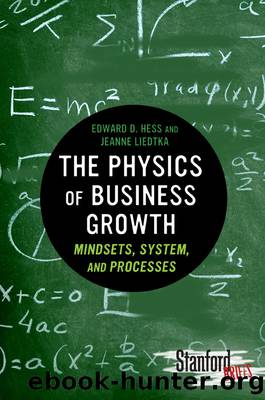The Physics of Business Growth by Edward Hess

Author:Edward Hess
Language: eng
Format: epub
Publisher: Stanford University Press
Published: 2012-08-15T00:00:00+00:00
Myths About Creativity
The origin of great creative ideas has been the source of almost as many myths as there are about growth: myths about who can be creative and how, and even about what creativity is. Letâs take a few minutes to dispel them so that we can get to the truth about idea generation.
Myth 1: Only certain kinds of people can think creatively.
Our research challenges common beliefs about what âinnovativeâ people look and act like, where we find them, and how they do what they do. Meet Dave Jarrett of Crowe Horwath, one of the largest CPA firms in the United States.1 Dave joined the firm in 1975 and spent the next 20 years there as an auditor and tax expert. He was then asked to head up an internal group tasked with generating ideas that would deliver better value to Crowe Horwath clients in profitable ways, while enhancing the firmâs capability set.
Daveâs challenge was a daunting oneâfor many reasons. Perhaps the most obvious was that few people saw accounting and tax firms as hotbeds of creativity. Dave knew that he and his colleagues were generally stereotyped as linear thinkers, not well-suited to seeing and developing creative new ideas. They were also seen as risk avoidersâreluctant to try unproved things out of fear of damaging important client relationships.
Yet Dave knew that innovation required a willingness to take some risks and pursue âout of the boxâ solutions. He and his colleagues would need to learn to accept failures in the process, but failure, he knew, was expensive: a working prototype often required an investment of more than $25,000 in new software. Dave also believed that clients ought to be involved much earlier in discussions about the value of new ideasâbut again, his colleagues were reluctant to show their clients âunfinishedâ work.
Dave wondered whether there were ways to surmount these obstacles, so he started looking for new approaches and tools. He found these in use at innovation and design firms like IDEO and applied them to the innovation process at Crowe Horwath. He brought together multi-disciplinary teams and used all the knowledge in the room to brainstorm new solutions and then translated these quickly into simple, low-cost prototypes. These prototypes often took the form of simple storyboards, which he and his colleagues used to engage clients in a conversation about the potential of the new idea to meet their needs. On the basis of clientsâ feedback, Dave and his group would iterate toward what they hoped was a better solution and then seek additional feedback as to whether they were on track.
The storyboard sessions, Dave emphasized, were never about trying to sell clients something. They were about understanding the extent to which the new idea created value for clients and soliciting information on how to improve it.
From a financial viewpoint, Daveâs approach was much less expensive than prior practices. Furthermore, Daveâs colleagues discovered that clients enjoyed the conversations. As Dave explains it: âSo now weâve got a few hours invested in the storyboards and some guys going out and meeting with their clients.
Download
This site does not store any files on its server. We only index and link to content provided by other sites. Please contact the content providers to delete copyright contents if any and email us, we'll remove relevant links or contents immediately.
Hit Refresh by Satya Nadella(8347)
The Compound Effect by Darren Hardy(7586)
Change Your Questions, Change Your Life by Marilee Adams(6667)
Nudge - Improving Decisions about Health, Wealth, and Happiness by Thaler Sunstein(6646)
The Black Swan by Nassim Nicholas Taleb(6209)
Daring Greatly by Brene Brown(5663)
Deep Work by Cal Newport(5513)
Principles: Life and Work by Ray Dalio(5340)
Rich Dad Poor Dad by Robert T. Kiyosaki(5173)
The Myth of the Strong Leader by Archie Brown(4796)
Man-made Catastrophes and Risk Information Concealment by Dmitry Chernov & Didier Sornette(4754)
Big Magic: Creative Living Beyond Fear by Elizabeth Gilbert(4741)
The Slight Edge by Jeff Olson(4732)
Discipline Equals Freedom by Jocko Willink(4649)
Digital Minimalism by Cal Newport;(4587)
The Motivation Myth by Jeff Haden(4542)
Stone's Rules by Roger Stone(4426)
Management Strategies for the Cloud Revolution: How Cloud Computing Is Transforming Business and Why You Can't Afford to Be Left Behind by Charles Babcock(4141)
The Doodle Revolution by Sunni Brown(4055)
